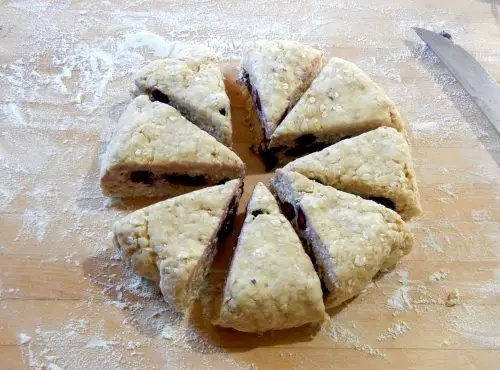Scones are a popular baked good, enjoyed by people worldwide. They are often made with flour, butter, milk, and sugar and can be served plain or with toppings like jam or cream. While scones are a relatively simple recipe to prepare, many bakers wonder if it’s possible to refrigerate scone dough before baking. In this article, we will explore the benefits and drawbacks of refrigerating scone dough and offer tips for creating delicious scones every time.
Understanding Scone Dough
Before we delve into the topic of refrigerating scone dough, let’s first understand what goes into making this type of baked good. A typical scone recipe may contain flour, sugar, baking powder, salt, butter or margarine, eggs (sometimes), and milk. The method used to mix the ingredients will often result in three different types of scones: flaky, cakey or crumbly.
A flaky scone is created by rubbing cold butter into the flour mixture until small pebbles form; then liquid is added gradually until it forms a cohesive dough. A cakey scone recipe usually calls for more sugar than other recipes and will include at least one egg yolk that is mixed in with the wet ingredients before adding it to the dry ones. To produce crumbly scones requires using less liquid or manipulating the dough less during mixing.
Refrigeration as Dough Preparation Technique
Refrigeration can be an excellent technique for preparing many different types of baked goods. With refrigeration comes several benefits: extended shelf-life for most doughs; flexibility to begin prepping early without worrying about over-proofing; allowing flavors to meld- all without negatively impacting texture too much!
Using refrigerated scone dough before baking isn’t uncommon but isn’t necessarily part of every baker’s repertoire. For some recipes,- especially those that call for more cakey types of scones,- the dough must be refrigerated for a period before shape, so it’s good to know the technique!
Knowing whether or not it’s appropriate to use refrigerated scone dough depends on the recipe and how you plan to bake them. Below are some benefits and drawbacks for using refrigeration.
Benefits of Refrigerating Scone Dough
- The extended shelf-life allows for more flexibility. The dough can be prepped well in advance.
- Aged dough allows flavors to meld- adding greater depth to the final product.
- Cold dough is firmer making shaping easier and improving overall appearance.
Drawbacks of Refrigerating Scone Dough
- Not all recipes are suitable for refrigeration due to ingredients’ active enzymatic or leavening properties
- You have less opportunity during last-minute adjustments- such as adding additional liquid- as cold fats are immovable.
- Over-manipulating cold, firm scone dough can cause gluten development, which leads to stretchy, tough texture
Factors that Influence Refrigeration Success
Several different factors come into play when it comes to successfully incorporating refrigeration into your scone prep method:
1. Dough Composition and Consistency
The primary ingredients in scone mix (flour, sugar, water/butter/milk) great starting point when deciding if your recipe is suitable for refrigeration.
Moisture content: If your recipe calls for too little liquid or high hydration levels (like wetter cakey-type recipes), avoid taking nutrients out of the fridge and working with them straight away because they may turn out dry after baking
Acidity: For best results regarding flavor profile, make sure you choose a dough that has an acidic ingredient like lemon juice, apple cider vinegar or buttermilk.
Fat Content: When there’s a high fat content present in your mixture (like flaky/crumbly-type recipes) the dough will carry a heavier weight. This results in taking more time to adjust to the baking process after refridgeration.
2. Shaping and Scoring Considerations
One aspect of scone preparation involves shaping and scoring the dough before baking, and your method can have a profound impact on texture and appearance post-bake.
Texture: Flatter-shaped scones cooked at higher temps are usually made by transferring cold scone dough directly into hot oven temp. Throw them right in there- you don’t need to bring them up warm first!
Appearance: For a smoother, less craggy exterior after baking, make sure that any cutter you’re using is sharp so it cleanly cuts through the dough without squishing the edges together.
Potential Risks: Because it’s inflexible when cold, over-handling your dough during shaping/scoring can lead to development of gluten; ultimately impacting taste/texture
Best Practices for Using Refrigerated Scone Dough
- Follow recipe instructions carefully
- Chill shaped dough portions rather than storing in one large lump.
- Allow the chilled scones to come up room-temperature slowly before preheating; this helps adjust for timing adjustments needed depending on individual oven behaviors.
- Brush a thin layer of melted butter over each scone before popping them into the oven -this helps maintain flakiness once baked
Chilled fridge-stored scone dough will take longer to cook due to its decreased temperature but resist opening doors frequently and instead opt for tentative checking at 12/13min preventing heat loss compromises.
If there are leftovers, wrap cooled baked goods tightly with clingfilm or put inside an air-tight container – they’ll hold well till about day five otherwise moisture loss will produce less than desirable results.
Variations in Recipes and Strategies by Region/Culture
Scones have become a staple in many parts of the world, with each region or cultural group putting its twist on this classic baked good. Although scones’ general ingredients and methods are recognizable efforts have been made to adapt traditional preparations for diverse palates and dietary preferences. North America is known for its preference of cakier, sweeter versions, whereas British style varieties typically feature less-sweet and flakier.
In some cases though, mainly where cream is used as a basis instead of milk – refrigeration could be essential to maintain the structural integrity of chilled scone dough.
Conclusion: Recommendations for Refrigerating Scones Dough Before Baking
Refrigerating scone dough before baking can be a useful technique when preparing sweetened or flaky-type recipes. Not all recipes work best using the chill process during preparation stages; however,- It’s generally best to opt for chilling shaped portions if possible rather than storing dough as a single mass. If done correctly, these stellar tips should give you an excellent starting point to enjoy the delicious fruits of your baking labor!
Q&A
Q: Can you refrigerate scone dough before baking?
Q: Will refrigerating scone dough benefit the texture of the baked scones? A: Yes, refrigerating scone dough can improve the texture of the baked scones. The chilling process allows the butter to solidify and create air pockets when baked, resulting in a flakier and more tender texture.
Q: How long can I refrigerate scone dough before baking it? A: Scone dough can be chilled for up to 24 hours before baking for optimal results. Any longer than that may cause the dough to become too firm and difficult to shape.
Q: Should I wrap my scone dough before putting it in the fridge? A: Yes, it is recommended to wrap your scone dough tightly in plastic wrap or a zip-top bag before placing it in the fridge. This will prevent any odors from other foods in your fridge from seeping into the dough and creating an unpleasant taste.
Q: Can I freeze scone dough instead of refrigerating it? A: Yes, you can freeze your scone dough for up to three months. Once ready to bake, let the frozen dough thaw in the fridge overnight before shaping and baking as usual.





